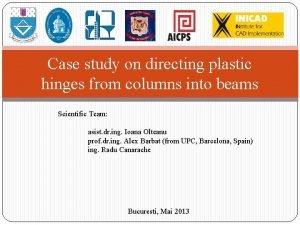Disease Its often taught that history hinges upon












- Slides: 12

Disease It's often taught that history hinges upon great battles, both in war and among competing ideas. The stars of history are usually a few powerful individuals, presidents, monarchs or dictators whose actions can shift a society's development one way or another.

But the most influential players in history are nasty, ruthless, and microscopic. Throughout history, bacteria, parasites, and viruses have swept through cities, devastated populations, killed great leaders, and in their wake transformed politics, public health, and economies.

As violent as people can be towards one another, the biggest executioner of the human race has been deadly disease. It’s hard to imagine in this day of super antibiotics and advanced medicine, but there was a time in history when a single disease could cause the deaths of thousands of people overnight.

Smallpox • Symptoms included body aches, high fevers, and a rash that results from fluidfilled bumps that leave extensive scarring on the skin. • After the vaccination campaigns of the 20 th century, smallpox has been declared eradicated. • In the 20 th century, the death toll was estimated at nearly 500 million. (90 million American Indians in 1500’s)

• This disease is suspected to have been around for thousands of years. • It usually spreads through contaminated food and water, and targets the human nervous system, which causes symptoms that usually affect the legs and lead to paralysis. • Though there is no cure for this disease, a vaccine was developed in the 1950 s that has proved effective for decades. Polio

• Name is from the Latin malus=bad, and aria=air • One of the most lethal infectious diseases in history, malaria causes over 300 million cases worldwide and up to 3 million deaths a year. • This mosquito born infectious disease (Anopheles mosquito) causes symptoms that typically include fever and headache, which in severe cases can progress to coma or death. • Cured by quinine (tonic water), an antimalarial drug derived from the bark of the cinchona tree. Malaria

• Known as flu, symptoms include cough, fever, sore throat, shaking chills, body aches, runny nose. • Excessive fluid buildup in the lungs (pneumonia) is what ultimately caused the death of millions. • In 1918, the disease very likely influenced the course of World War I by sickening and killing soldiers, and sickening President Wilson at negotiations during the Treaty of Versailles. Influenza

The Black Death • Also known as the Bubonic Plague, The Black Death is considered to be the first true pandemic on earth. • It cut populations in half throughout parts of the world like Asia and Europe in the fourteenth century. • Caused by the bacterium, Yersinia pestis, and carried by rats, symptoms of Black Death included swollen lymph glands called buboes, fever, cough, bloody mucus and difficulty breathing.

• Most often spread through contaminated water and food, cholera causes flu-like symptoms like vomiting, diarrhea, cramping, and severe dehydration • The dehydration leads to the death of those who cannot keep properly hydrated as their immune system fights the disease. • Unfortunately, outbreaks are still occurring today, with the most recent cholera outbreak in Haiti in 2010. Cholera

Yellow Fever • This disease is related to malaria in that it spreads from person to person through infected mosquitoes. • It is a life-threatening disease that can cause severe internal bleeding and liver failure, which is marked by the yellowing of the skin – prompting this disease’s name. • Wiped out entire colonies and villages during the time of Napoleon, killed thousands in New Orleans in 1853, slowed the building of the Panama Canal, limited the development of the southern United States.

Measles • The measles virus is the cause of an infection of the respiratory system. Symptoms include fever, cough, runny nose, red eyes and a rash. • The virus is highly contagious and is spread by coughing and sneezing via close personal contact or direct contact with secretions. Complications include diarrhea, blindness, inflammation of the brain, and pneumonia among others. • Vaccination has resulted in a 75% decrease in deaths from measles between 2000 and 2013 with about 85% of children globally being currently vaccinated.

• Smallpox cowpox https: //www. youtube. com/watc h? v=yq. UFy-t 4 Ml. Q • Pandemics https: //www. youtube. com/watc h? v=UG 8 Yb. Nbdaco • Crash course on famine and disease
 Samet hinges
Samet hinges Holy lord hinges
Holy lord hinges Ngoại tâm thu thất chùm đôi
Ngoại tâm thu thất chùm đôi Block nhĩ thất cấp 1
Block nhĩ thất cấp 1 Thể thơ truyền thống
Thể thơ truyền thống Thơ thất ngôn tứ tuyệt đường luật
Thơ thất ngôn tứ tuyệt đường luật Chiến lược kinh doanh quốc tế của walmart
Chiến lược kinh doanh quốc tế của walmart Tìm độ lớn thật của tam giác abc
Tìm độ lớn thật của tam giác abc Hãy nói thật ít để làm được nhiều
Hãy nói thật ít để làm được nhiều Tôn thất thuyết là ai
Tôn thất thuyết là ai Gây tê cơ vuông thắt lưng
Gây tê cơ vuông thắt lưng Sau thất bại ở hồ điển triệt
Sau thất bại ở hồ điển triệt Always often rarely never
Always often rarely never






















